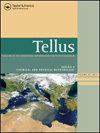利用多约束方法估算澳大利亚大陆区域陆地碳通量
IF 4.3
4区 地球科学
Q3 METEOROLOGY & ATMOSPHERIC SCIENCES
Tellus Series B-Chemical and Physical Meteorology
Pub Date : 2003-04-01
DOI:10.1034/J.1600-0889.2003.00031.X
引用次数: 46
摘要
我们已经开发了一个模型框架,它综合了不同时空尺度上的各种类型的现场测量。我们使用该模型框架估算了1990年至1998年间澳大利亚大陆8个地区的总光合作用、总生态系统产量、净初级产量(NPP)和净生态系统产量(NEP)的月均值及其标准差。1990年至1998年间,澳大利亚大陆的年平均NPP在800至1100 Mt C yr - 1之间变化,其变异系数定义为标准差与平均值的比值在0.24至0.34之间。整个大陆NPP的季节变化在50 ~ 110 Mt C月- 1之间,有两个最大值,一个在秋季,另一个在春季。NEP在冬季最负(碳汇),在夏季最正(碳源)。然而,月平均NEP的变异系数非常大(> 4),因此对1990-1998年期间整个大陆任何月份净碳通量的预测置信度非常低。另一篇论文将把大气反演技术应用于二氧化碳浓度的测量,以进一步限制大陆碳循环,减少估计的月平均碳通量的不确定性。本文章由计算机程序翻译,如有差异,请以英文原文为准。
Estimating regional terrestrial carbon fluxes for the Australian continent using a multiple‐constraint approach
We have developed a modelling framework that synthesizes various types of field measurements at different spatial and temporal scales. We used this modelling framework to estimate monthly means and their standard deviations of gross photosynthesis, total ecosystem production, net primary production (NPP) and net ecosystem production (NEP) for eight regions of the Australian continent between 1990 and 1998. Annual mean NPP of the Australian continent varied between 800 and 1100 Mt C yr−1 between 1990 and 1998, with a coefficient of variation that is defined as the ratio of standard deviation and mean between 0.24 and 0.34. The seasonal variation of NPP for the whole continent varied between 50 and 110 Mt C month−1 with two maxima, one in the autumn and another in the spring. NEP was most negative in the winter (a carbon sink) and was most positive (a carbon source) in the summer. However, the coefficient of variation of monthly mean NEP was very large (> 4), and consequently confidence in the predicted net carbon fluxes for any month in the period 1990–1998 for the whole continent was very low. A companion paper will apply atmospheric inverse technique to measurements of CO2 concentration to further constrain the continental carbon cycle and reduce uncertainty in estimated mean monthly carbon fluxes.
求助全文
通过发布文献求助,成功后即可免费获取论文全文。
去求助
来源期刊
自引率
0.00%
发文量
3
期刊介绍:
Tellus B: Chemical and Physical Meteorology along with its sister journal Tellus A: Dynamic Meteorology and Oceanography, are the international, peer-reviewed journals of the International Meteorological Institute in Stockholm, an independent non-for-profit body integrated into the Department of Meteorology at the Faculty of Sciences of Stockholm University, Sweden. Aiming to promote the exchange of knowledge about meteorology from across a range of scientific sub-disciplines, the two journals serve an international community of researchers, policy makers, managers, media and the general public.

 求助内容:
求助内容: 应助结果提醒方式:
应助结果提醒方式:


